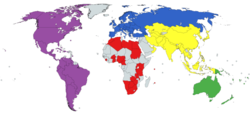Under 21 National Championships
The Under 21 National Championships followed a full round-robin and semi-final (1st v 4th, 2nd v 3rd), winners play in the Gold Medal match until 2014.
Since 2014 these championships have operated with two pools of four teams, with the top two teams in each pool qualifying for the medal pool (1st-4th), and the bottom four teams qualifying for the classification pool (5th-8th).
Since 2018 the structure has changed slightly with every two pools of four teams. From there crossover quarterfinals occur with 1st place in Pool A playing 4th place from Pool B, 2nd in Pool A playing 3rd in Pool B and so on, this replicated the finals format from the World League. In the 2018 Men's Championship [54] it meant that Tasmania who lost all three pool games were able to win three knockout matches and be crowned National Champions. Under the format from 2017, [55] this would not have been possible.
Under 18 National Championships
The Under 18 National Championships followed a full round-robin and semi-final (1st v 4th, 2nd v 3rd), winners play in the Gold Medal match until 2014.
From 2014 onwards the championships have been contested by ten teams, with New South Wales and Victoria each fielding 2 teams, although in some cases it was Queensland and not Victoria. This required the creation of two pools of five teams each with crossover semi-finals of 1st in Pool A playing 2nd in Pool B and vice versa, the winners playing in the Gold medal match, loser playing for third place.
In 2016 the number of teams increased to eleven with the addition of a second Queensland team.
In 2022 this increased to 12 teams with the addition of a second team from Western Australia.
These four states' teams are selected as a First and Second team, these are their names: New South Wales State & New South Wales Blue Victoria & Victoria Development Queensland Maroon & Queensland Gold Western Australia Gold & Western Australia Black
Under 16 National Championships
In 2024, Hockey Australia shifted this age group to Under 16. [56]
The Under 15 National Championships followed a full round-robin with the 1st and 2nd ranked teams to play in the Gold Medal match, 3rd and 4th placed teams playing for third place and so on, until 2009.
From 2010 to 2013 Hockey Australia did not play a finals series, so the winners were the teams ranked highest on the ladder after the round-robin competition.
In 2014 Hockey Australia increased the number of teams to twelve with the stronger states (New South Wales, Queensland, Victoria, Western Australia) fielding two teams each. This required the creation of two pools of six teams each with crossover semi-finals of 1st in Pool A playing 2nd in Pool B and vice versa, the winners playing in the Gold medal match, the loser playing for third place.
These four states' teams are selected as a First and Second team, these are their names: New South Wales State & New South Wales Blue Victoria & Victoria Development Queensland Maroon & Queensland Gold Western Australia Gold & Western Australia Black
Under 14 National Championship
In 2024, Hockey Australia shifted the age group to Under 14 and made it a National Championship, [57] with a focus not just on participation, but also excellence. It followed a full round robin, but added a playoff game to the schedule (e.g. Final/Gold Medal is 1st v 2nd, Bronze Medal is 3rd v 4th etc...).
The Under 13 National Championship was included as a full National Championship from 2011 (with the inclusion of all States and Territories). Prior to this, an invitational event was run and sanctioned by Hockey Australia but did not hold National Championship status. There are no finals series and the Champion is the team ranked highest on the ladder at the conclusion of the competition.
In 2014 Hockey Australia increased the number of teams to 12 with the stronger states (New South Wales, Queensland, Victoria, Western Australia) fielding two teams each.
In 2015 Hockey Australia renamed this event as an Australian Carnival, with the stronger states (New South Wales, Queensland, Victoria, Western Australia) required to pick even teams in order to promote participation over elitism.
Despite this request Victoria continually picks a first and a second team as evidenced by their results (e.g. 2022 [28] Boys Victoria Venom 1st, Victoria Volt 11th, 2019 [58] Victoria Venom 1st, Victoria Volt 10th).
Other states have suggested averaging finishing positions to determine an Overall Winner (e.g. 2022 [28] Boys, Western Australia should be crowned champions, with WA Lightning 2nd & WA Storm 3rd, equals an average of 2.5, Queensland Runners-Up, with Queensland Cutters 4th & Queensland Sabres 6th, equals an average of 5, Victoria in third place with Victoria Venom 1st & Victoria Volt 11th, equals an average of 6, and New South Wales in fourth place with NSW Lions 5th & NSW Stars 8th, equals an average of 6.5).
Matches are also shortened to 20-minute halves with a full round-robin, with teams required to often play double headers (two games) in one day.
In 2019 this was changed to four 10-minute quarters.
